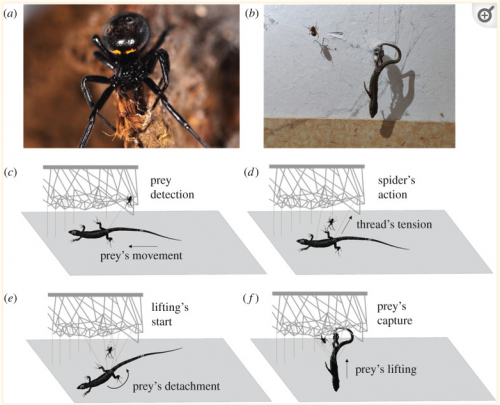Hey! I was watching my spiders do this just yesterday!

(a) An adult Steatoda paykuliana female of the family of Theridiidae (courtesy of Alessandro Kulczycki, Aracnofilia – The Italian Association of Arachnology). (b) A Steatoda triangulosa that captured a lizard (Podarcis muralis) by using lifting technique (courtesy of Emanuele Olivetti). Schematic of the technique used to lift the prey. (c) The prey is detected by the capturing threads and, once it is, (d) the spider starts to attach pre-tensioned threads to it. (e) When the weight of the prey is won by vertical component of the sum of the tensions the prey detaches from the surface and (f) starts to be lifted.
It was a feeding day. Little critters like Drosophila are easily handled — I saw one swoop down on a drag line to a fly walking on the floor, hog-tie it with a couple of quick flicks of silk, and then haul it up in one smooth motion. That was impressive.
However, these guys do kill and consume prey many times their size. I saw one snag a mealworm, which then went into a frantic writhing struggle and broke free, ending up on the floor of the container. The spider dived on it, trussed it up again, and then hoisted it up about 10cm to the heart of its cobweb. They are amazingly strong, and as the diagram illustrates, very clever about leveraging the structure of their web to secure their prey.
I have not tried feeding them small vertebrates yet, but the lab next door to mine is a herpetology lab, full of spider food. Don’t tell Heather Waye, she isn’t personally keen on spiders already, and hearing that they might have designs on her research animal would not be very endearing.
OK, I’ll stick to invertebrates.


OT
I am just reading John Connolly’s thriller ‘The Killing Kind’ where spiders play a substantial role, as explained in the introduction.
Connolly lives in Maine, a state that has given rise to many odd churches and cults, a fact that he uses to great effect (he is one of the few writers who can pull off a thriller-urban gothic- horror hybrid)
Like Stephen King he has no time for demagogues, -political or religious- and his villains often hide in weird cults leaving mass graves and derelict churches behind.
Besides, not that I’ve ever done research on live subjects, but as soon as you get into vertebrates doesn’t the ethical-treatment paperwork multiply by like a factor of 10?
inflection @ 2
Since invertebrates are quite capable of feeling pain, this difference is unfair.
Herps of the World are having a hard enough time as it is, aren’t they?
Come on now.
Now, if you are breeding more spiders than you need…
Did you read Children of Time by Adrian Tchaikovsky? Portia labiata features prominently.
All SF books by Tchaikovsky are worth reading.
When I was a kid and lived in New Mexico I had a pet tarantula. During the day it was very slow and not too active. But at night I’d feed it crickets and watch Sir Hairy Hobbs pounce on his victim crickets with lightning speed. I miss old Hairy!
OT: It appears you were right in questioning the quality of Newsweek. Look what they are running in their opinion section:
How Science Stopped Backing Atheists and Started Pointing Back to God by Stephen C-word Meyer
@8 – at least he’s taking a pretty good beating in the comments.
Spider silk is pretty good stuff.
The Infinite Thread is dead.